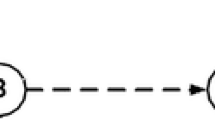Abstract
In this paper, we present, test, and compare two novel methods to solve the aircraft routing problem with aerial refueling with a multicriteria objective function. We present a mixed-integer linear program (MILP) that utilizes a combination of a network transformation and a formulation that creatively decouples refueling decisions from the nodes within the network. We also present a dynamic program (DP) that, when coupled with an alternative network transformation to account for the multiple criteria within the objective function, applies a node-labeling approach based on a modification of Dijkstra’s algorithm. We test and compare these alternative solution methods on a set of 264 synthetically-generated instances representing 66 combinations of network size and the frequency of aerial refueling point availability. Invoking CPLEX using the C++ callable library to solve the MILP and applying the DP in C++, we found that the application of the DP yields a 98.97 % reduction in the required computational effort, on average, relative to the MILP; the MILP fails to find an optimal solution within a 3,600-s time limit for selected instances of networks having at least 80 nodes and for all instances of networks having at least 350 nodes. In contrast, the DP is more robust than the MILP, as it only requires longer than 3,600 s to solve selected instances of networks having more than 3,000 nodes.


Similar content being viewed by others
Notes
We use the attained optimality gap rather than the relative optimality gap reported directly by CPLEX, as the commercial solver computes its reported gap by dividing the the absolute optimality gap by the magnitude of the best integer-feasible objective function value [16] (i.e., the lowest feasible upper bound).
References
Ahuja, R.K., Magnanti, T.L., Orlin, J.B.: Network flows: Theory, Algorithms, and Applications. Prentice Hall, Upper Saddle River (1993)
Barnhart, C., Belobaba, P., Odoni, A.R.: Applications of operations research in the air transport industry. Transp. Sci. 37(4), 368–391 (2003)
Barnhart, C., Boland, N.L., Clarke, L.W., Johnson, E.L., Nemhauser, G.L., Shenoi, R.G.: Flight string models for aircraft fleeting and routing. Transp. Sci. 32(3), 208–220 (1998)
Bartholomew-Biggs, M.C., Parkhurst, S.C., Wilson, S.P.: Using direct to solve an aircraft routing problem. Comput. Optim. Appl. 21(3), 311–323 (2002)
Bartholomew-Biggs, M.C., Parkhurst, S.C., Wilson, S.P.: Global optimization approaches to an aircraft routing problem. Eur. J. Oper. Res. 146(2), 417–431 (2003)
Bazaraa, M.S., Jarvis, J.J., Sherali, H.D.: Linear Programming and Network Flows. Wiley, Hoboken (2011)
Bellman, R.: On a routing problem. Technical report, DTIC Document (1956)
Bush, B.A.: Analysis of fuel consumption for an aircraft deployment with multiple aerial refuelings. Ph.D. thesis, North Carolina State University (2006)
Crino, J.R., Moore, J.T., Barnes, J.W., Nanry, W.P.: Solving the theater distribution vehicle routing and scheduling problem using group theoretic tabu search. Math. Comput. Model. 39(6), 599–616 (2004)
Desaulniers, G., Desrosiers, J., Dumas, Y., Solomon, M.M., Soumis, F.: Daily aircraft routing and scheduling. Manag. Sci. 43(6), 841–855 (1997)
Dumitrescu, I., Boland, N.: Algorithms for the weight constrained shortest path problem. Int. Transp. Oper. Res. 8(1), 15–29 (2001)
Erdoğan, S., Miller-Hooks, E.: A green vehicle routing problem. Transp. Res. Part E: Logist. Transp. Rev. 48(1), 100–114 (2012)
Feillet, D., Dejax, P., Gendreau, M., Gueguen, C.: An exact algorithm for the elementary shortest path problem with resource constraints: application to some vehicle routing problems. Networks 44(3), 216–229 (2004)
Harder, R.W., Hill, R.R., Moore, J.T.: A java universal vehicle router for routing unmanned aerial vehicles. Int. Trans. Oper. Res. 11(3), 259–275 (2004)
Hart, P.E., Nilsson, N.J., Raphael, B.: A formal basis for the heuristic determination of minimum cost paths. IEEE Trans. Syst. Sci. Cybern. 4(2), 100–107 (1968)
IBM. CPLEX user’s guide, 2014. Accessed Jun 30 2014 at: http://pic.dhe.ibm.com/infocenter/cosinfoc/v12r5/index.jsp
Irnich, S., Desaulniers, G.: Shortest Path Problems with Resource Constraints. Springer, Berlin (2005)
Kannon, T.E., Nurre, S.G., Lunday, B.J., Hill, R.R.: The aircraft routing with air refueling problem: Exact and greedy approaches. In: Proceedings of the Industrial and Systems Engineering Research Conference, Montreal, Canada (2014)
Lockheed Martin Inc., Specifications: F22 raptor, December 2013. Accessed Jan 31 (2014) at: http://www.lockheedmartin.com/us/products/f22/f-22-specifications.html
O’Rourke, K.P., Carlton, W.B., Bailey, T.G., Hill, R.R.: Dynamic routing of unmanned aerial vehicles using reactive tabu search. Mil. Oper. Res. 6(1), 5–30 (2001)
Righini, G., Salani, M.: New dynamic programming algorithms for the resource constrained elementary shortest path problem. Networks 51(3), 155–170 (2008)
Royset, J.O., Carlyle, W.M., Wood, R.K.: Routing military aircraft with a constrained shortest-path algorithm. Mil. Oper. Res. 14(3), 31–52 (2009)
Smith, O.J., Boland, N., Waterer, H.: Solving shortest path problems with a weight constraint and replenishment arcs. Comput. Oper. Res. 39(5), 964–984 (2012)
Sundar, K., Rathinam, S.: Algorithms for routing an unmanned aerial vehicle in the presence of refueling depots. IEEE Trans. Autom. Sci. Eng. 11(1), 287–294 (2014)
Acknowledgments
The authors thank the Editor and two anonymous referees for their constructive comments and suggestions that have greatly helped improve the substance and presentation of this paper.
Author information
Authors and Affiliations
Corresponding author
Rights and permissions
About this article
Cite this article
Kannon, T.E., Nurre, S.G., Lunday, B.J. et al. The aircraft routing problem with refueling. Optim Lett 9, 1609–1624 (2015). https://doi.org/10.1007/s11590-015-0849-8
Received:
Accepted:
Published:
Issue Date:
DOI: https://doi.org/10.1007/s11590-015-0849-8




